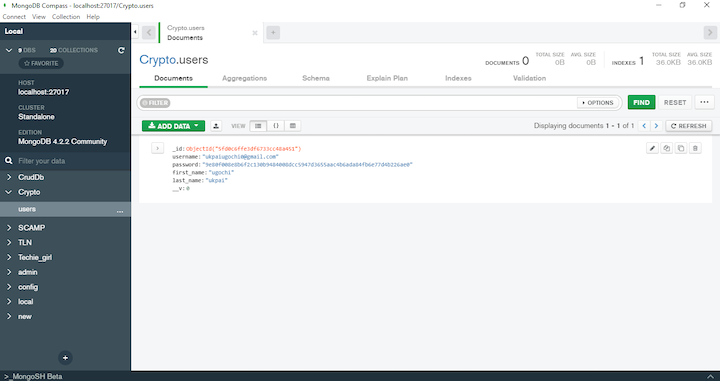
- #ENCRYPTO NODE JS HOW TO#
- #ENCRYPTO NODE JS INSTALL#
- #ENCRYPTO NODE JS UPDATE#
- #ENCRYPTO NODE JS FULL#
- #ENCRYPTO NODE JS FREE#
Websites should now exclusively use TLS 1.0-1.2, the successors to the deprecated SSL protocols. The second change I made was to disable support for the SSL 2 and SSL 3 protocols. See the Node TLS/SSL documentation for details. This can be changed manually via the ciphers option when creating the HTTPS server and by setting honorCipherOrder to true. It turns out that older versions of Node use an outdated default cipher list.
#ENCRYPTO NODE JS UPDATE#
The first big “fix” was to update my Node installation to v5, as described in the Node package manager documentation. SSL Labs report after a few hours of fixing config issues Ciphers and Protocols I figured I would document some of the fixes I made in case anyone else runs into the same problems. When I first ran my personal website through the test I received a score of C due to some flaws in my server configuration after fixing the issues and rerunning I improved my site score to an A. The report also includes an letter grade that indicates how well the website did overall. It performs a battery of tests and produces a detailed report that describes any configuration issues or vulnerabilities found during testing.
#ENCRYPTO NODE JS FREE#
SSL Labs provides a free service that can be used to analyze the SSL configuration of a webserver.
#ENCRYPTO NODE JS FULL#
Using the full path or a sym link avoids this step. I wouldn’t recommend copying the certificate files though - when it comes time to renew the certificate in four months, you’ll also have to remember to copy the new files to the web app. pem files in a subdirectory of the web app and reference those, rather than specifying full file paths. It may be more convenient to create sym links to the. Key: fs.readFileSync("/etc/letsencrypt/archive//privkey1.pem"),Ĭert: fs.readFileSync("/etc/letsencrypt/archive//fullchain1.pem"),Ĭa: fs.readFileSync("/etc/letsencrypt/archive//chain1.pem")



If someone accidentally visits, perhaps from a stale link, they’ll be redirected to. This isn’t necessary/desirable in all cases, but it’s a simple way to force all incoming traffic to use the secure connection. Note that I also start an HTTP server that redirects requests to the HTTPS server. The app passed in to the server can be any requestListener, such as an Express web app instance or a handler function.
#ENCRYPTO NODE JS HOW TO#
The following code listing shows how to start an HTTPS server using the certificate files. Following through all of the steps in the toolchain will produce four files, which are most likely placed in the directory /etc/letsencrypt/archive//. letsencrypt-auto certonly -standalone -d -d Needless to say, and email should replaced with real values. To use Let’s Encrypt with Node, I ran it with the following command-line options. Your mileage may vary on other Linux distributions. At the time of writing I was unable to find a LE package using APT on Ubuntu, but there was a package listed on the Debian web interface. There’s also a Node package listed on npm - I haven’t tried this myself, but it seems to allow for tighter integration of Let’s Encrypt and Node applications. The recommended way in the official guide is to simply clone the LE repo to a local directory.
#ENCRYPTO NODE JS INSTALL#
There are a variety of ways to install the Let’s Encrypt toolchain. There are a few other free alternatives, but since LE is backed by Mozilla and Google the root certificate comes installed in most browsers. Most popular CAs such as Comodo, GoDaddy or Symantec charge fees when issuing and renewing SSL certs, however Let’s Encrypt is completely free. I chose to use Let’s Encrypt as my certificate authority for a variety of reasons, the foremost being cost. The security warning change is supposedly going to be a part of mainline Chrome in the near future, so I decided that it was probably time to configure HTTPS on my personal website. Access to the site would still be permitted, but the user would be notified of potential security risks. Rather than showing a generic white icon, the Chrome Security Team proposed that HTTP websites show a security warning similar to the red lock above. As such, there’s an initiative at the Chromium Project to inform users whenever they access content over insecure connections. Many users, however, are unaware that accessing websites over HTTP is also insecure.

It’s quite obvious that something is wrong when a website displays the red lock in fact, it is often accompanied by an error page describing the problem. Chrome browser icons for secure HTTPS, insecure HTTPS and regular HTTP connections


 0 kommentar(er)
0 kommentar(er)
